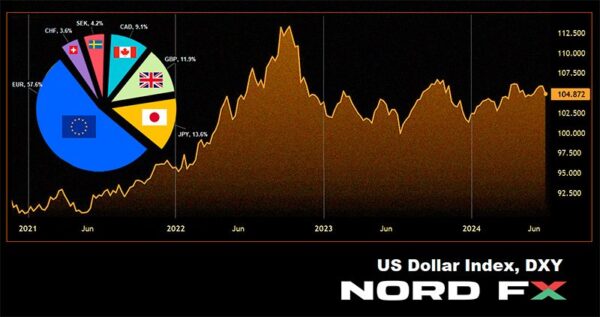News
Forex and Cryptocurrency Forecast – Action Forex

EUR/USD: The US is Not Very Good, Europe is Not Very Bad
On Friday, June 5, the Dollar Index (DXY) hit a three-week low, while the euro showed its largest weekly gain against the dollar in a year. This was due to the US not performing as well as expected and Europe not faring as poorly.
Disappointing private sector employment statistics from ADP (150K versus the forecasted 163K and previous 157K) and an increase in repeated jobless claims (238K versus 234K) for the ninth consecutive week indicate a cooling labour market. The slowdown in business activity in the service sector, the fastest in four years, and the drop in the ISM Index from 53.8 to 48.8 points, below the threshold of 50.00, suggest that the US economy is not as smooth as the Federal Reserve (Fed) would like.
The FOMC’s June meeting minutes mentioned that monetary policy should be ready to respond to economic issues, a sentiment echoed by Fed Chairman Jerome Powell. Consequently, this gloomy macroeconomic data increased the likelihood of a monetary expansion cycle and interest rate cuts in September from 63% to 73%. Derivatives are almost certain that there will be two 25 basis point (bp) cuts in 2024, lowering the rate from 5.50% to 5.00%. This caused US Treasury yields and the DXY to drop, while stock indices and EUR/USD rose. The S&P500 set its 33rd record this year, and EUR/USD reached a high of 1.0842 on July 5.
The euro was also bolstered by the situation in France. The left-wing “New People’s Front” (NFP) and the government bloc “Together for the Republic” (Ensemble) joined forces to prevent the right-wing from gaining power, which might end successfully. If the right-wing “National Rally” (RN) does not gain an absolute majority in the new parliament after the second round of elections, there will be no confrontation with the EU or Frexit (analogy with British Brexit).
Polls indicate the right-wing will secure 190 to 250 out of 577 seats, while 289 are needed for an absolute majority. The second round of elections will be held on Sunday, July 7, which might cause gaps in euro pairs on Monday.
Last week, the euro was also supported by the European Central Bank, or rather, by the minutes of its June Governing Council meeting. On one hand, 25 out of 26 Council members voted for a 25 basis point rate cut. However, this decision was made with several caveats concerning still high wage growth rates and the persistence of inflation, which resists and does not want to drop to the target level of 2.0%.
Preliminary June data showed that the CPI decreased only by 0.1% from 2.6% to 2.5%, and the Core CPI remained at 2.9% (y/y), above the consensus forecast of 2.8%. ECB officials fear the CPI might rise due to geopolitical tensions, supply chain disruptions, raw material and energy price increases, and other factors. This almost rules out a rate cut at the ECB Governing Council meeting on July 18 and suggests only one act of monetary expansion in the second half of 2024.
Key US labour market data released at the end of the week on Friday, July 5, could change the dollar’s position and the EUR/USD dynamics. According to the Bureau of Labour Statistics (BLS), non-farm payrolls (NFP) increased by 206K in June, lower than May’s 218K but above the forecast of 190K. Other data showed the unemployment rate rose from 4.0% to 4.1%, and wage inflation dropped from 4.1% to 3.9% (y/y).
After the publication of this data, EUR/USD ended the week at 1.0839. However, this does not mean it will start the next week at this level. Traders are closely watching the French elections and the political situation related to the November US presidential elections. Biden’s interview with ABC News at 00:00 GMT on Saturday, July 6, when markets are closed, could also impact dollar pairs.
As of the evening of July 5, analysts’ forecasts for the near future are as follows: 55% predict the pair will rise, 45% foresee a fall. In technical analysis, all trend indicators and oscillators on D1 are in favour of the euro, although a quarter indicate the pair is overbought. The nearest support is in the 10790-10805 zone, followed by 1.0725, 1.0665-1.0680, 1.0600-1.0620, 1.0565, 1.0495-1.0515, 1.0450, and 1.0370. Resistance zones are at 1.0890-1.0915, 1.0945, 1.0980-1.1010, 1.1050, and 1.1100-1.1140.
Notable events in the upcoming week include Jerome Powell’s testimony in the US Congress on July 9 and 10, updated CPI data for Germany and the US on Thursday, July 11, and US initial jobless claims. The week will end with Germany’s retail sales data and the US Producer Price Index (PPI) and the University of Michigan Consumer Sentiment Index.
GBP/USD: The Pound Gained with the Labour Party
The pound sterling and British stocks rose after the opposition centre-left Labour Party secured a convincing victory in the parliamentary elections. The British currency achieved a weekly gain of 1% – the best in the last seven weeks.
According to Reuters, the Labour Party won 337 out of 650 seats, indicating a majority in the House of Commons. UK Prime Minister Rishi Sunak conceded defeat and congratulated his opponents on their victory. In turn, Labour Party leader and Prime Minister-elect Keir Starmer declared that from today “we are embarking on a mission of national renewal and starting to rebuild our country.” Starmer will replace Sunak as Prime Minister, ending 14 years of Conservative rule.
The markets responded positively to the national election results. The pound became the only component of the DXY to strengthen (by 0.2%) this year. “Apart from the weakening of the dollar,” commented Singapore’s DBS Bank, “the markets warmly welcomed the victory of the opposition Labour Party. This will put an end to years of political and economic uncertainty under Conservative leadership following the Brexit referendum in 2016. Labour leader Keir Starmer, while he is alive, has ruled out the possibility of the UK joining three blocs – the EU, the single market, and the customs union. […] However, Labour may seek more favourable trade agreements by aligning with EU rules in specific sectors such as agriculture, food, and chemicals.”
“As for monetary policy,” continued DBS strategists, “the OIS market assesses a 62.4% probability of the Bank of England (BoE) cutting the rate by 25 basis points to 5.0% at the meeting on August 1.” However, DBS believes this will not significantly harm the pound, provided that expectations for a Fed rate cut in September increase.
The final note of the five-day period saw the GBP/USD pair at 1.2814. Specialists from another Singaporean bank, UOB, believe the likelihood of the pound strengthening has increased. They note that a strong resistance level is in the area of last month’s high of 1.2860. The median forecast for the near term is as follows: 35% of analysts expect further pound strengthening and pair growth, 50% foresee a decline, and the remaining 15% are neutral. As for technical analysis on D1, 100% of trend indicators are green. Among the oscillators, 90% are green, a third of which are in the overbought zone, and the remaining 10% are neutral grey. In case of further decline, the pair will find support levels and zones at 1.2735-1.2750, 1.2680, 1.2655, 1.2610-1.2625, 1.2540, 1.2445-1.2465, 1.2405, and 1.2300-1.2330. In case of growth, the pair will meet resistance at levels 1.2850-1.2860, followed by 1.2895, 1.2965-1.2995, 1.3040, and 1.3130-1.3140.
Among the events of the coming week, the publication of UK GDP data for May on Thursday, July 11, stands out. The next important event, as previously mentioned, will be the publication of a fresh inflation report in the United Kingdom on July 17.
USD/JPY: Back to 1986
The yen lost over 12% against the dollar this year due to the large interest rate differential between Japan and the US. It continued to lose ground in the first half of the past week, reaching a new 38-year high of 161.94 on Wednesday, July 3, but failed to break above 162.00 due to disappointing US statistics.
Until Friday, Japanese officials largely refrained from discussing possible interventions. According to several experts, they may fear the wrath of the United States following sharp remarks from American authorities regarding recent similar actions. However, on July 5, Finance Minister Shunichi Suzuki once again stated that the authorities would closely monitor the state of the stock and currency markets. A week earlier, he expressed that he was “deeply concerned about excessive and unilateral movements in the forex market” and hoped that “confidence in the Japanese currency remains.”
OCBC Bank economists noted that “USD/JPY will follow US Treasury yields and the dollar. A reversal in USD and a Fed rate cut or a BoJ signal to normalize (rate hike or accelerated balance sheet reduction) is needed for a downward reversal, none of which seem to be happening.” OCBC concluded that the path of least resistance for USD/JPY might still be upward unless there is intervention. “Intervention, at best, is a tool to slow the yen’s depreciation, not to reverse the trend,” they added.
The week ended with USD/JPY at 160.78. UOB Group analysts noted that the pair’s upward momentum is starting to weaken, but only a break below 160.45 would indicate that the USD will not strengthen further. If the pair breaks above 162.00, the next level to watch is 163.00. OCBC economists see further targets for USD/JPY at 164.00 and 164.90, with support at 160.20, 158.10 (21 DMA), and 156.90 (50 DMA).
Many traders remain cautious, fearing another intervention by Japanese authorities. 65% of analysts expect another intervention and a southward movement of the pair, while the remaining 35% point north. Among trend indicators on D1, only 10% point south, with the rest looking north. Oscillator indicators are 25% red and 75% green.
No significant macroeconomic data is expected for Japan in the upcoming week.
CRYPTOCURRENCIES: Back to February 26
The last five days of June gave investors hope that the black streak was over. But alas! On the first day of July, the bulls’ strength waned, and BTC/USD turned south again, easily breaking support around $60,000 and plummeting to a local bottom at $53,543, a level last seen on February 26.
A long time ago, in 1961, the 35th President of the United States, John Fitzgerald Kennedy, uttered a phrase that became famous: “Victory has a thousand fathers, but defeat is an orphan.” So, the current victory of the bears over the bulls also has many “fathers,” although not a thousand. Several factors influenced the decline of the crypto market.
Firstly, investor disappointment that bitcoin failed to reach a new all-time high (ATH) after the April halving. Due to the halving of their reward, BTC miners were forced to sell a significant amount of their coins to cover operational costs. It was reported that their reserves reached a 14-year low. Downward pressure was also exerted by the German government, which began selling a large amount of bitcoin (about 50,000 BTC) seized by the police from a pirate site in January.
Sales intensified sharply after the announcement on June 24 that creditor payments from the bankrupt crypto exchange Mount Gox (Mt.Gox) would start in early July. These assets had been blocked, and now 20,000 former clients are to receive a total of 162,100 BTC (about $9 billion). According to a K33 study, the anticipation of this event put significant pressure on digital asset prices. Traders assumed that most recipients would be inclined to sell their tokens, given that BTC’s price had risen exponentially since 1994. Real panic ensued when test transactions were observed on wallets associated with Mt.Gox.
According to Quinn Thompson, CEO of the crypto hedge fund Lekker Capital, the market has largely accounted for the German government’s actions and Mt.Gox creditor payments. Thus, this negative pressure is expected to gradually weaken, as noted by Fundstrat analyst Tom Lee.
Another disappointment was the anticipated launch of Ethereum exchange spot ETFs last week, which did not materialise. The US Securities and Exchange Commission (SEC) rejected the applicants’ S-1 form submissions, requesting additional adjustments by July 8. Therefore, approval may occur closer to mid-month or later, if at all. As a result, investors withdrew a record $119 million over the past two weeks, the highest since August 2022, making Ethereum an outsider in the crypto market.
Overall, global cryptocurrency exchange-traded funds recorded a third consecutive week of outflows, losing a total of $1.2 billion in investments. Most of the losses came from US spot Bitcoin ETFs, with about half of the inflows coming from retail investors, who typically lack long-term planning and patience. Many whales also began to take profits due to the absence of positive signals. The stock market also played against digital assets. In the last two months, both the S&P500 and Nasdaq Composite consistently hit record highs, prompting some investors to shift their funds from cryptocurrencies to stocks.
Despite the current gloomy outlook, many experts remain cautiously optimistic about the future. MN Trading founder Michaël van de Poppe believes an upward reversal will occur with the upcoming listing of Ethereum ETFs. Another expert, Ali Martinez, noted that in previous years, when June ended in a downtrend, there was a sharp rise the following month: historically, bitcoin gained an average of 7.42%. However, he believes July may be more challenging than usual due to the shock from Germany’s bitcoin sales and Mt.Gox creditor payments.
Santiment analysts observed that both bullish and bearish sentiments in X, Reddit, Telegram, 4Chan, and BitcoinTalk networks are waning, indicating traders’ loss of interest in trading. “We interpret this as fear and apathy among the crowd – a potential bottom signal,” Santiment noted. “At the same time, there is increased talk about holding cryptocurrencies, which could be a positive sign.”
“Bears still control the situation, but bitcoin is heavily oversold,” said analyst Willy Woo. He believes markets will correct the oversold condition, but at this stage, it does not indicate fundamental demand growth or guarantee a sustained bullish trend. Woo emphasized that a breakout of the resistance line on the daily bitcoin RSI chart will create a “technical but not fundamental recovery.”
According to Blockware Intelligence experts, bitcoin needs to overcome the $65,000 level to develop a rebound. This level corresponds to the acquisition cost for short-term investors. Currently, the digital gold prices have dropped below the total cost of short-term holders for the first time since August 2023. “Last summer, under similar circumstances, the price remained in a sideways trend for another two months before breaking out again," added Blockware Intelligence specialists.
Pratik Kala, a DigitalX analyst, predicts consolidation and low volatility for the crypto market in July. He stated, “Bitcoin is looking for the next major catalyst to move up. It’s not visible on the horizon yet, but things will change as the US elections approach.” Quinn Thompson from Lekker Capital also believes that the current “overly bearish” sentiments will gradually shift. He sees the US presidential elections as a growth catalyst for the crypto market, along with increased liquidity from the Fed and the launch of spot ETH ETFs. Another reason for growth could be the increased profitability of mining. Thompson predicts bitcoin will reach $100,000 and Ethereum $7,000 by November.
Galaxy Digital founder Mike Novogratz shares Thompson’s view, recently forecasting bitcoin will hit $100,000 by the end of 2024. Tom Lee of Fundstrat expects an even higher figure of $150,000.
As of writing this outlook on the evening of Friday, July 5, BTC/USD is trading at $56,400 and ETH/USD at $2,975. The total crypto market capitalization is $2.06 trillion ($2.24 trillion a week ago). The market lost about $625 billion over the last 30 days. The Crypto Fear and Greed Index dropped from 47 to 29 points in 7 days, moving from the Neutral zone to the Fear zone.
News
US Cryptocurrency Rules Delayed by ‘Never-Ending’ Lawsuits

Ripple CEO says cryptocurrency industry still seeking regulatory clarity from US
Speaking to Bloomberg News on Wednesday (July 17), Author: Brad Garlinghouse he said America is behind behind other countries which have already adopted cryptocurrency regulations.
“What we’re seeing, where it’s the UK, Japan, Singapore… even the European Union, more than two dozen countries have come together to provide a framework for cryptocurrency regulation,” Garlinghouse said.
“It’s frustrating that we as a country can’t get that regulatory framework in place. And instead, we have this never-ending lawsuit coming from the SEC that doesn’t really address the problem.”
Ripple has been the target of some of these legal disputes. Securities and Exchange Commission (SEC) sued the company in 2020, accusing it of conducting a $1.3 billion operation offering of unregistered securities tied to its XRP token.
However, last year a judge ruled that only Ripple’s institutional sales of XRP, not retail sales, violated the law, a decision widely seen as a victory for the cryptocurrency industry.
As PYMNTS noted at the time, that ruling has “far-reaching repercussions impact across the digital asset ecosystem, which has long maintained that its tokens do not represent securities contracts.”
However, Garlinghouse told Bloomberg on Wednesday that the company cannot wage multimillion-dollar legal battles over each token.
He spoke to the news agency from the Republican National Convention in Milwaukee, where the party is backing the candidacies of former President Donald Trump and Ohio Sen. J.D. Vance, both of whom are considered pro-cryptocurrency.
But Garlinghouse argued that cryptocurrencies “should not be a partisan issue,” and noted that he had recently attended a conference in Washington that included Democrats, including White House officials.
“I think they were there, listening to the industry… it was refreshing to start having that conversation,” she said.
President Joe Biden earlier this year he vetoed a measure which would have ended the SEC’s special rules for crypto-asset custodians. This legislation was supported by both the digital asset industry and the banking industry.
Ripple early this year donated $25 million to the cryptocurrency industry’s super PAC Fair Smoothiewith Garlinghouse stating at the time that such donations would continue every year, as long as the industry had its detractors.
Second Open SecretsWhich monitor spending For campaigns, the PAC has spent $13.4 million this year, much of it to help defeat Rep. Katie Porter’s (D-Calif.) U.S. Senate campaign.
News
The Future of Cybersecurity in the Cryptocurrency Industry

The cryptocurrency space has had a tumultuous journey, with its fair share of ups and downs. As we look to the future, one area that remains a constant focus is cybersecurity. The digital nature of cryptocurrencies makes them inherently vulnerable to cyber threats, and as the industry evolves, so does the landscape of potential risks.
In 2022, the cryptocurrency market faced significant challenges, with over $2 trillion in market value lost. This event served as a wake-up call for the industry, highlighting the need for robust cybersecurity measures. The future of cryptocurrency security is expected to see a shift towards more regulated and established institutions taking the reins of crypto technology and blockchain infrastructure.
The decentralized nature of cryptocurrencies offers numerous benefits, such as transparency and financial inclusion. However, it also introduces unique security challenges. The risk landscape is filled with threats such as hacking, phishing, ransomware attacks, malware, and social engineering. These threats not only lead to financial losses, but also damage the reputation and trust within the cryptocurrency ecosystem.
Mini-MBA Tekedia edition 15 ((September 9 – December 7, 2024) started recordings; Register today for discounts reserved for early bird customers.
Tekedia AI in Business Masterclass Opens registrations Here.
Join the Tekedia Capital Syndicate and IInvest in Africa’s best startups Here.
The decentralized nature of cryptocurrencies offers many benefits, but it also presents unique security challenges. Cyber risks such as hacking, phishing, and ransomware pose threats to the integrity of digital assets. The infrastructure that supports cryptocurrencies is not immune to vulnerabilities, including smart contract flaws and exchange hacks.
To address these vulnerabilities, the infrastructure that supports cryptocurrencies must be strengthened. Smart contract vulnerabilities, exchange hacks, wallet breaches, and flaws in the underlying blockchain technology are significant concerns that must be addressed to ensure the security and integrity of digital assets.
As cybercriminal tactics and techniques become more sophisticated, the cryptocurrency industry must stay ahead of the curve. The future will likely see more targeted attacks, exploiting weaknesses in infrastructure, networks, and human factors. This requires a proactive and multifaceted approach to cybersecurity.
To mitigate these risks, several measures must be adopted:
Strengthening security measures: Developers, exchanges, and wallet providers must improve security protocols, use strong encryption, implement multi-factor authentication, and conduct regular security audits.
Education and awareness: Users should be educated on best practices for protecting their digital assets, including using strong passwords, recognizing phishing attempts, and using hardware wallets for secure storage.
Looking ahead, the cryptocurrency industry is expected to see an increased focus on robust security measures. Blockchain projects and exchanges are likely to invest in advanced encryption techniques and decentralized storage solutions to protect user assets. The future impact of cyber risk on cryptocurrencies will depend on the collective efforts of stakeholders to address vulnerabilities and strengthen security measures.
Collective efforts by stakeholders in the cryptocurrency space are crucial to address vulnerabilities and strengthen security measures. While challenges persist, advances in cybersecurity technologies and practices offer hope for a more secure and resilient cryptocurrency ecosystem.
The future of cybersecurity in the cryptocurrency industry depends on finding a balance between innovation and regulation. It requires a collaborative effort from all parties involved, from developers to end users, to create a secure environment that fosters trust and growth in the industry. As we move forward, it is critical that lessons learned from past events guide the development of stronger security measures, ensuring the longevity and stability of cryptocurrencies as a vital part of the modern economic toolkit.
Like this:
Like Loading…
News
Bullish XRP and RLBK price predictions rise, outpacing the broader cryptocurrency market, prompting Shiba Inu holders to switch!

Bitcoin’s one-week surge from $60,000 has pushed other cryptocurrencies into an uptrend. However, for many altcoins, this trend has been temporary. Altcoins such as XRP and Shiba Inu (SHIB) have experienced price drops. However, Rollblock, a new altcoin on the Ethereum blockchain, has thrived during this period, attracting thousands of investors looking for long-term growth.
XRP’s Nearly 30% Growth Over Last Week Drops as Selling Pressure Increases
XRP is seeing further price decline as Ripple investors withdraw their profits from the token. The surge in XRP’s price to $0.64 in the past week has provided investors with a perfect opportunity to increase their returns in the short term. With the ongoing sell-off in XRP, XRP has jumped over 8% in the past day and is now trading at $0.59. However, analysts tracking XRP indicators predict that XRP could still extend its gains by over 30% in the coming weeks.
Shiba Inu (SHIB) marks its third consecutive day of losses
Shiba Inu (SHIB) is in a period of adjustment after a week of strong gains. In the last 24 hours, SHIB has seen a jump of over 7%, reflecting a natural market fluctuation. Analysts are observing a death cross on the Shiba Inu chart, which historically signals the potential for future opportunities as the market stabilizes. As investors explore new possibilities, some are diversifying into promising altcoins like Rollblock (RBLK) to strategically rebalance their portfolios and capitalize on the emerging trend.
Rollblock (RBLK) Up Another 7% as New Investors Join Pre-Sale
Rollblock (RBLK) has taken the cryptocurrency market by storm, having attracted investors from more popular altcoins like Shiba Inu (SHIB) and XRP. Rollblock’s growth is attributed to its utility in the $450 billion global gaming industry.
Rollblock aims to use blockchain technology to bridge the gap between centralized and decentralized gambling. With blockchain technology, Rollblock secures every transaction in its online casino, providing transparency and convenience to millions of players who are uncomfortable placing bets on other iGaming platforms.
This innovative use of blockchain technology in the industry has grown Rollblock to over 4,000 new users in less than two months. With plans to add sports betting, this number is expected to grow exponentially in Q3.
Rollblock uses a revenue sharing model that splits up to 30% of its casino’s weekly profits with token holders. This happens after Rollblock buys back $RBLK from the open market and uses half of it for rewards. The other half is burned to increase the price of $RBLK.
Rollblock price has seen four increases in the past month with $RBLK tokens now selling for $0.017. Analysts predict that at the current growth rate, Rollblock could increase by over 800% before the presale ends. For investors looking for a long-term token with growth potential, phase four is the best time to buy Rollblock before its price skyrockets!
Discover the exciting Rollblock (RBLK) pre-sale opportunities now!
Website:https://Rollblockpresale.io/
Social: https://linktr.ee/Rollblockcasino
No spam, no lies, just insights. You can unsubscribe at any time.
News
Texas Crypto Miners Turn to AI as Crypto Declines

As cryptocurrency mining becomes less profitable, Texas cryptocurrency mining companies are switching to supporting artificial intelligence companies.
Bitcoin miners, with their sprawling data centers and access to significant energy resources, are ideally suited for computationally intensive AI operations, and as cryptocurrency mining becomes less profitable, companies see this shift as a logical answer to their problems.
On Thursday, Houston-based Lancium and Denver-based Crusoe Energy Systems announced a multibillion-dollar deal to build a 200-megawatt data center near the West Texas city of Abilene to support advanced artificial intelligence applications such as medical research and aircraft design, CNBC reported. The plant represents the first phase of a larger 1.2 gigawatt project.
Lancium and Crusoe’s move into AI mirrors a broader trend among bitcoin miners. The combined market capitalization of the top U.S.-listed bitcoin miners hit a record $22.8 billion in June. Companies like Bit Digital and Hut 8 are diversifying into AI, with Bit Digital securing a $92 million annual revenue deal to supply Nvidia GPUs and Hut 8 raising $150 million to expand its AI data center.
But the growing popularity of these operations also presents challenges, particularly for the Texas power grid. Last month, the Electric Reliability Council of Texas announced that the state is expected to nearly double its energy production by 2030 to meet the high energy demands of data centers and cryptocurrency operations.
Lieutenant Governor Dan Patrick expressed concern about the projections.
“Cryptocurrency miners and data centers will account for more than 50% of the additional growth. We need to take a close look at these two sectors,” He wrote on Twitter/X. “They produce very few jobs compared to the incredible demands they place on our network. Cryptocurrency miners could actually make more money selling electricity to the network than they do from their cryptocurrency mining operations.”
Analysts predict significant growth in data center power capacity, which is expected to account for up to 9% of U.S. electricity consumption by 2030.
The operations also pose challenges for nearby cities. Earlier this month, TIME reported that a crypto-mining facility was seriously compromising the health of residents in the city of Granbury. TIME reported more than 40 people with serious health problems, including cardiovascular disease, high blood pressure and hearing loss. At least 10 of the residents needed to go to the emergency room or an urgent care facility.
The disturbances were caused by the extreme noise generated by the crypto-mining facility’s fans, which are used to keep the machines cool. While the proposed data center in Abilene would use liquid cooling systems, it’s still unclear whether the facility’s operations would pose a health risk to local residents.
-

 Nfts1 year ago
Nfts1 year agoShardLab Launches ZK-Based Tool for Digital Identity and NFT Vouchers
-

 News1 year ago
News1 year agoWallet recovery firms are abuzz as stranded cryptocurrency investors panic in the bitcoin boom
-

 Bitcoin12 months ago
Bitcoin12 months agoBitcoin, Ethereum, Solana and Cryptocurrency Markets Look Ready to ‘Send’ as Stars Align, According to Investor Chris Burniske
-

 Altcoins12 months ago
Altcoins12 months agoThree Altcoins Poised for Significant Growth in 2024: ETFS, OP, BLAST
-

 Altcoins12 months ago
Altcoins12 months agoAccumulate these altcoins now for maximum gains
-

 Nfts12 months ago
Nfts12 months agoOG Crypto Artist Trevor Jones Unveils Groundbreaking Collection of Ordinals | NFT CULTURE | NFT News | Web3 Culture
-

 Bitcoin12 months ago
Bitcoin12 months agoBillionaires are selling Nvidia stock and buying an index fund that could rise as much as 5,655%, according to some Wall Street analysts
-

 Videos8 months ago
Videos8 months agoKamala just won the boner! [Bad For Crypto]
-

 Videos1 year ago
Videos1 year agoLIVE FOMC 🚨 Could be CATASTROPHIC for Altcoins!
-

 Videos1 year ago
Videos1 year agoAttention: a historically significant BITCOIN signal has just appeared!
-

 News1 year ago
News1 year agoA Guide for Newcomers & Beginners – Forbes Advisor
-

 Videos1 year ago
Videos1 year agoSTOCK MARKET FUD! ⚠️ [Why This Is GREAT For Bitcoin Traders!]

















